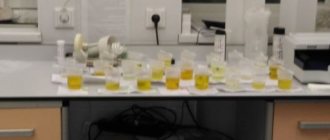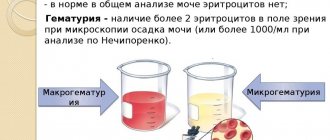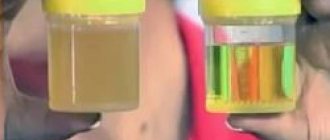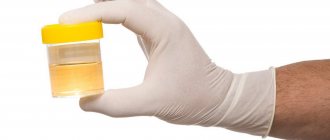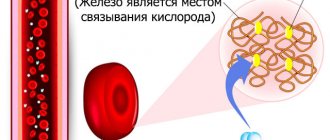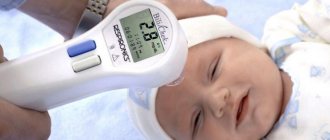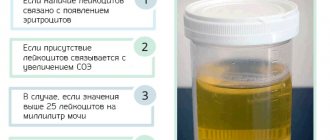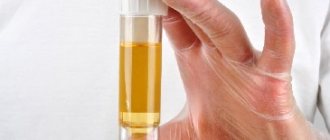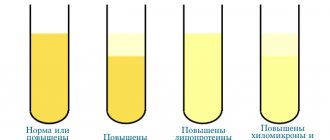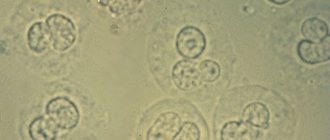Important facts about ascorbic acid
- Vitamin C is one of the most important vitamins for health. Its role is multifaceted: supporting nonspecific immunity, participating in the formation of adrenal hormones and collagen, maintaining the strength of blood vessels and cholesterol levels, increasing the absorption of iron, which supplies oxygen to cells, participating in carbohydrate and protein metabolism.
- This vitamin cannot be synthesized independently in the human body; it is supplied to the body from the outside - with food, juices, and pharmacy vitamins.
- Ascorbic acid is easily dissolved in water and quickly converted into other substances, so it does not accumulate. The acid penetrates platelets and then spreads throughout all tissues and organs. In the liver, ascorbic acid is metabolized into deoxyascorbic, oxaloacetic and diketogulonic acids.
- Vitamin C is excreted through the kidneys into the urine. When increasing doses to 200 mg, the level of absorption of vitamin C in the intestine decreases by 20%. Therefore, the level of ascorbic acid in the urine exceeds the norm. An increase in norms is associated with the formation of kidney stones. Stones are formed due to the deposition of the acid itself and due to the active formation of oxalic acid, which is involved in the formation of stones.
- Lack of ascorbic acid leads to various diseases, such as anemia, scurvy and varicose veins.
There are many reasons for changes in the concentration of ascorbic acid in urine and they are dangerous, therefore, if the test results are negative, additional tests are prescribed.
Associated symptoms
Deviation of acid levels in urine is accompanied by various symptoms. Increased level :
- stones in the kidneys;
- rash on the surface of the body;
- change in the color and odor of urine;
- increased irritability and excitability;
- nausea;
- headache;
- diarrhea;
- signs of poisoning.
Reduced level:
A lack of vitamin C in pregnant women can cause premature birth or fetal death.
Norms for ascorbic acid content in urine
The amount of vitamin C intake is determined depending on the person’s gender, age and certain physiological conditions. For a child, the norm is 0.04 - 0.08 g per day, and for an adult 0.06 - 0.1 g. During pregnancy, women are recommended to increase their daily intake of ASA to 1 g, since in this case it is necessary not only enhance immunity, but also ensure sufficient vitamin 2 content of the body.
In the absence of any pathologies, a person with urine should secrete 30 mg of ASA per day, which will indicate the normal course of metabolic processes. For children, this figure is in the range of 20-30 mg per day. If the concentration of vitamin C in the blood reaches 100 mg or higher, then this indicator will increase in the urine. In this case, it is necessary to carry out diagnostics to identify the disease that caused such a deviation.
Reasons for increasing vitamin C
Often children have increased ascorbic acid in the urine. The reason for this is most often poor nutrition. Parents often try too hard to enrich their baby’s diet with vitamins. In this case, the child is often fed citrus fruits, and sometimes additionally given ascorbic acid in tablets. All this leads to hypervitaminosis.
It is important to remember that a child needs from 30 to 75 mg of vitamin C per day (depending on age). A systematic excess of ascorbic acid in food can lead to the formation of stones in the excretory organs and a deficiency of B vitamins. In teenage girls, hypervitaminosis causes hormonal disorders.
However, poor nutrition is not the only cause of deviations from the norm in the analysis. Vitamin C in urine can be increased in case of kidney disease. In this case, the excretory organs cannot cope with the processing of ascorbic acid, and this substance leaves the body in increased quantities.
The reason for the increase in this compound in the urine can be the use of sleeping pills, non-steroidal painkillers, as well as the abuse of multivitamin complexes. Often parents give their children sweet ascorbic acid with glucose in unlimited quantities. But we must remember that vitamins are medicines. And their overdose can negatively affect the child’s body.
Indications for urine analysis to detect ascorbic acid content
A urine test is prescribed for severe signs of vitamin deficiency and hypovitaminosis.
With vitamin deficiency due to a lack of C, patients experience the following symptoms:
- inflammation and bleeding of gums;
- loosening and loss of teeth;
- delayed wound healing;
- the appearance of bruises, pale skin;
- weight loss, sluggish appetite;
- disturbances in intestinal function;
- pain in the legs and joints.
Hypervitaminosis leads to the appearance of symptoms:
- sour smell of urine;
- irritation in the tissues of the urethra;
- chronic headaches;
- itchy skin.
The same symptoms are possible in other diseases; a urine test is the easiest way to determine whether they are associated with ascorbic acid or not.
Asc must be determined in pregnant women, people with hormonal disorders, cancer patients, in patients suffering from rheumatism, kidney disease, liver disease, and those who have suffered burns.
The analysis is also prescribed if it is necessary to obtain accurate results of the content of bilirubin, hemoglobin and glucose. The examination is carried out before these tests. If asc is elevated, the results will be skewed.
What it is?
Ascorbic acid is otherwise called vitamin C. It is found in foods such as citrus fruits, rose hips, currants, bell peppers, and dill. Vitamin C is needed by the body to maintain the following functions:
- hormone production;
- cholesterol processing;
- strengthening vascular walls;
- functioning of the immune system;
- rapid skin regeneration and wound healing;
- oxidation reactions.
A deficiency of this substance causes vitamin deficiency, which is accompanied by bleeding gums, tooth loss and pain in the lower extremities. However, excess ascorbic acid is also harmful and can lead to urethral irritation, chronic headaches and itchy skin.
It is important to remember that ascorbic acid can only enter our body through food. Therefore, in mild cases of vitamin deficiency and hypervitaminosis, changing the diet is sufficient.
Norms for ascorbic acid content in urine in adults
Normally, ascorbic acid is found in the blood (up to 100 mg) and in the urine (on average 30 mg). Vitamin C released in the urine indicates whether or not there are disturbances in the normal course of the metabolic process in cells.
High performance liquid chromatography-mass spectrometry (HPLC-MS) is used as a research method. Asc is measured in urinalysis in mcg/ml (micrograms per ml). You can also use test strips, but such an analysis can hardly serve as a basis for quality examination and treatment.
The table shows the reference average values of ask in urine analysis of people of different ages.
- Ascorbic acid in urine: causes of high and low vitamin levels
| Patient | Norm, mcg/ml (in daily portion) | Violations |
| Adult men | 25-30 | from 35 |
| Adult women (outside pregnancy and lactation) | 30-35 | from 40 |
| Pregnant women | 30-35 | from 45 |
| Breastfeeding women | 30-35 | from 65 |
| Babies under one year old | 1,93 – 21 | from 21 |
| Teenagers under 14 years old | 3,6 – 29 | from 29 |
| Boys, girls under 19 years old | 3 – 22 | from 22 |
The results of medical studies show that in women the normal concentration of ascorbic acid in the urine, and accordingly in the cells, is higher than in men.
The physiological need during pregnancy increases to 100 mg/day. Therefore, in the urine of pregnant and lactating women, the content of ascorbic acid in the analysis may increase above the norm by 10 mg and 30 mg, respectively.
A deviation of ascorbic acid concentration from normal levels in any direction is a reason to be examined and review your diet.
The norm of ascorbic acid and its excess
For both men and women, the rate of ascorbic acid in urine is the same: the daily portion should be about 30 mg. If the concentration is within this limit, then the person does not have metabolic diseases. If the increase is insignificant, it is quite possible that the person has recently simply increased the dose of consumption of products containing this substance.
If the content of the element in the urine is more than 100 mg (this threshold is considered to be exceeded), then we can talk about the presence of a disease. Although, again, this may be due to changes in diet - it is necessary to analyze the lifestyle recently.
An increase in concentration may also occur as a result of taking certain medications. Sometimes a course of therapy leads to similar phenomena.
It can be:
- Ascorbic acid itself can be taken by taking medications that contain it.
- Aspirin and other anti-inflammatory drugs.
- Barbiturates are drugs that are classified as narcotic drugs.
- Medicines taken for epilepsy.
In first place among the ailments that provoke an increase in the concentration of such useful acid is urolithiasis. As the disease progresses, the kidneys begin to secrete too much ascorbic acid - over time, it settles there, forming sand, then stones. Gradually the concentration increases, which leads to colic if not treated in time.
What can cause an unreliable research result?
There are cases when a general analysis showed a normal amount of ascorbic acid in the urine, but clinical signs of metabolic disorders still occur. Then the patient is asked to retake the test after a certain time. Factors that can distort the result of the study and make it difficult to decipher it include:
- incorrect collection of material or untimely delivery to the laboratory;
- drinking alcohol or smoking shortly before collecting biological material;
- difficult climatic conditions during sample delivery to the laboratory;
- taking hormonal medications, including contraceptives in women;
- poisoning by poisons, aggressive chemical compounds;
- serious allergic reactions;
- infectious diseases;
- infancy;
- oncological problems;
- stress and strong psycho-emotional outbursts;
- physical or mental overload;
- a sharp change in climatic living conditions;
- work in conditions harmful to health due to chemical factors.
DETAILS: Acute cystitis in women: symptoms and treatment
If one or more of these factors is present, regular monitoring of ascorbic acid levels in urine should be established, even in the absence of an unpleasant odor.
How to prepare for donating urine (urine) so as not to distort the results
To obtain high reliability of urine test results, you must:
- Before collecting urine, wash the external genital organs.
- A couple of days before the test, you should avoid any foods that color your urine: beets, carrots, black currants, etc.
- The day before the test, you should not take medications that have a diuretic, laxative effect, contain vitamins, or hormonal contraceptives. You should inform your doctor about taking any medications, he will tell you whether they need to be discontinued.
- You will have to stop eating 8-12 hours before the procedure, but you can drink clean still water.
- One hour before the examination you should refrain from smoking.
Urine should be collected using a clean disposable container and taken to the laboratory as soon as possible. It is necessary to prevent dirty particles from entering the container.
Research methods
It is possible to clarify the acid content using a simple test - a test strip that can change its color at different concentrations of the component. The next way is to collect biological fluid in a clean container and bring it to the laboratory for testing. Before collecting urine, it is recommended not to take medications for two hours, and not to change your normal diet the previous day.
When the test strips show that the component is within the normal range, but all signs of change are quite obvious, you should test a second time and try to abstain from the substances that caused the poor results. This means that it is necessary to give up alcoholic beverages, stop taking birth control and hormonal medications, limit contact with plants containing poison, and avoid physical activity for several days.
Analysis transcript
Let's assume that a child has ascorbic acid in his urine. What does it mean? Isn't this a sign of pathology?
Ascorbic acid is present in urine in all people. Vitamin C enters the body with food and is excreted mainly through the kidneys. Excess of this substance is released along with urine. Therefore, the detection of vitamin C in urine does not indicate pathology; it is considered normal. Ascorbic acid can be found in very small quantities in a child’s urine.
You need to sound the alarm only in cases where the amount of vitamin in urine goes beyond acceptable limits. This indicates poor nutrition or the presence of pathology. The normal level of ascorbic acid in urine is considered to be about 30 mg. For infants, a reference value of up to 80 mg is allowed.
- Salts oxalates in the urine of a child
Urinalysis to detect ASA
The most commonly used are two main methods for studying the content of ascus in a patient’s urine.
- Using analyzers. The biomaterial is collected in a special way throughout the day into a pharmaceutical plastic container. Then he is taken to the reception point. From there it is sent to the laboratory, where it will be examined using modern reagents on analyzers.
- Test. It is also required to collect urine for twenty-four hours. Indicator strips are then used to determine the amount of ascorbic acid. This method can be used at home.
Indications for use
Urinalysis for ascus content is the most important study. Therefore, it is prescribed for the diagnosis and control of a number of serious diseases:
- suspected development of scurvy;
- frequent respiratory infections;
- recovery after surgery;
- treatment of burns;
- excessive formation of bruises and hematomas on the body at any age;
- multiple formation of petechiae;
- increased bleeding;
- dysfunction of the cardiovascular system;
- adrenal diseases;
- cancer screening;
- prolonged general malaise;
- liver pathologies;
- severe dysfunction of the digestive system;
- cachexia.
Persons recovering from serious illnesses, infectious diseases or injuries are also advised to study the content of ascorbic acid. Patients who have undergone blood transfusions, chemotherapy sessions or suffer from metabolic disorders should regularly submit urine for this test. It is often also recommended for women with hormonal imbalances, irregular cycles, and a number of gynecological dysfunctions.
Instructions for collecting urine at ASC
The study must show completely reliable results, therefore, before collecting biomaterial for analysis, a number of mandatory rules must be observed. It is necessary to completely eliminate the consumption of food containing ascorbic acid the day before. Oranges, lemons, broccoli, sea buckthorn, peppers, tomatoes, dill, black currants, chicory, rosehip infusion, sorrel, and apples are prohibited.
The day before the test collection, you should stop taking any pharmacological agents, except those approved by your doctor or those that cannot be cancelled. You should completely stop smoking and drinking alcohol while preparing for the study. Women are required to stop taking contraceptives.
Biomaterial for laboratory analysis is collected throughout the day in a special container. Before releasing it, it is necessary to thoroughly clean the genitals. After twenty-four hours, all the urine is thoroughly mixed.
Urine should be used for analysis no later than one hundred and twenty minutes after collection. It is poured into a sterile plastic container and, with the appropriate inscriptions, taken to the collection point.
Description of the research process
Laboratory determination of ascorbic acid content in urine is carried out using the Tilsman method. A special substance “2,6 Dichlorophenolidophenol” is used. The biomaterial is diluted with distilled water, then the solution is carefully filtered. Afterwards, a reagent is added to it and the color changes are waited for.
But the express test method is more often used. Special paper strips are produced for it. They are removed from the package and immediately used for research.
The test must be completely lowered into urine for five seconds, and then the degree of color change must be assessed using a special scale. Before making comparisons, you need to let the strips dry for the time specified in the instructions for use.
The intensity of the color corresponds to the quantitative parameter of the vitamin C content. The result is not based on stating the result using a “positive” or “negative” rating, but on clarifying the volume of the substance content.
Reasons for deviations from the norms
Decoding the analysis based on the level of urine asc concentration should take into account factors such as the patient’s age and gender, existing bad habits, and concomitant chronic diseases.
Increases C content in urine:
- Poor quality collection and storage of biomaterial for analysis. Do not overcool urine collected for analysis.
- Taking vitamin C in large doses, including in foods. In a single dose, consumption of more than 2 grams of ascorbic acid causes abdominal pain, attacks of nausea followed by diarrhea. Taking more than 3 grams causes increased production of liver enzymes.
- Smoking abuse.
- Taking aspirin, primidone, oral contraceptives, barbiturates and estrogens.
- Poisoning with toxins: pesticides, nitrosamines, heavy metals.
- Metabolic pathologies: impaired absorption of ascorbic acid by the body, urolithiasis of the kidneys.
An increased content of ascorbic acid often indicates that there is an accumulation of calculi (sand and stones) in the kidneys - oxalates, which contribute to the development of urolithiasis.
Reduces the content of ask in urine:
- Lack of vitamin C associated with macrobiotic diets, unbalanced nutrition, dehydration, gastrointestinal lavage procedures (for poisoning), intake of alkaline drinks and acid-quenching foods;
- The process of malabsorption is incomplete absorption in the small intestine, associated with disorders in the mucous membrane and other reasons, and loss of acid before entering the intestine.
- Taking medications: salicylates, calcium chloride, hormones, choline antibiotics.
- Oncological tumors, burns and other pathologies that require large amounts of vitamin C for tissue formation;
- Hormonal disorders associated with diseases of the thyroid gland (thyrotoxicosis), adrenal glands and ovaries. The formation of hormones in these organs occurs with the participation of ascorbic acid.
- Infections, autoimmune diseases that cause an increased immune response;
- Pregnancy in the last trimester, when the baby is actively growing;
- Renal failure - impaired filtering ability of the kidneys, hemodialysis procedure.
A lack of ascorbic acid disrupts the formation of connective tissues. Intracavitary, intradermal, and gingival hemorrhages occur, gums and joints become inflamed and painful, and hair falls out. In children, bone growth is impaired. The dryness of the skin is clearly visible. There is weakness with rapid fatigue.
Below normal
Increased levels of ASA in urine can be observed in the following situations:
- urolithiasis disease;
- the human diet includes an excessive amount of foods high in vitamin C (rose hips, black currants, peppers, cabbage, citrus fruits, sorrel);
- malabsorption of ASA due to damage to the intestinal walls (trauma, Crohn's disease, surgical interventions, infectious and autoimmune pathologies), lack of certain enzymes (amylase) and circulatory disorders;
- taking medications that cause increased secretion of this acid (barbiturates, nonsteroidal anti-inflammatory drugs, antiepileptic drugs);
- uncontrolled consumption of vitamin C;
- drug and alcohol use;
- chronic kidney pathology.
Additional diagnostics
It is selected by the doctor taking into account the results of urine diagnostics, additional tests already performed, the patient’s symptoms and complaints.
You can understand where the cause of the violations lies by conducting a series of studies.
- Blood chemistry. Shows exactly where the failure occurs. If the concentration of As in the blood is normal, but there is little C in the urine, then kidney function is impaired.
- Ultrasound of the abdominal cavity, kidneys, thyroid gland , adrenal glands. Detects tumors in organs.
- Blood tests for thyroid hormones
,
liver enzymes.
They show pathologies in the functioning of these organs. - Colonoscopy, gastroscopy.
Examination of the gastrointestinal tract using special flexible probes equipped with lights, video cameras and micro-instruments. - Urine tests using various methods
to detect kidney disorders. - Tests for infections, helminths (parasites), allergies
. Prescribed to identify the causes of increased immune response.
Why and when is it determined?
Vitamin C is considered a vital substance. It is involved in oxidative reactions, collagen synthesis, iron absorption and other biochemical processes.
However, such acid is not formed in the body, but must be regularly supplied with food. There is a lot of it in black currants, citrus fruits, bell peppers, rose hips, kiwi and many other products.
It is important to determine ascorbic acid in a child’s urine:
- When feeding infants with cow's milk;
- For infectious diseases in infants;
- If you suspect scurvy - bleeding gums, bruising on the skin, drowsiness, loss of strength, poor appetite and other alarming symptoms;
- For burns;
- With malabsorption syndrome;
- In case of liver dysfunction;
- With severe and frequent stress;
- During oncological processes;
- For long-term treatment with infusions.
With all such problems, a lack of vitamin C should be identified in time in order to correct such a deficiency either by nutrition or by taking vitamin supplements.
How is the analysis carried out?
To determine the level of ascorbic acid in a child’s urine, you need to do an ASA test. Urine for research is collected within 24 hours. The laboratory then determines your vitamin C levels using special test strips.
Before the study, you should avoid taking medications and vitamin supplements. Otherwise, the analysis may give false results. You should not change your usual diet, but on the eve of the study you should not abuse citrus fruits.
Currently, test strips for analysis can be purchased at pharmacy chains. The study can also be carried out at home. If the results deviate from the norm, the analysis should be repeated.
Indications for the study
Every person is recommended to check urine for acid content from time to time, and in pregnant women and newborns this component is monitored on an ongoing basis. In addition, people with signs of scurvy should submit their urine for testing. The following symptoms are characteristic of this pathology:
- numerous blue bruises on the skin;
- bleeding in the gums;
- feeling of drowsiness, loss of strength, poor health;
- hemorrhages under the skin of a point nature;
- poor appetite, severe weight loss;
- weakening of the immune system, manifested by increased frequency of colds;
- problems in the gastrointestinal tract;
- deviations in the performance of the heart muscle.
In addition, it is recommended for people who have multiple burns on their bodies and have undergone surgical interventions to keep the level of acid in urine under control.
Patients with oncology who have undergone a long infusion therapeutic course, and women suffering from problems with the ovaries should be under constant monitoring.
Persons who often suffer from nervous stress should periodically have their biological fluid tested to check the level of ascorbic acid. This mainly applies to those who abuse drugs and alcoholic beverages.
Treatment
In case of deviations from the norm, the test for ascorbic acid in urine is repeated. Additionally, a venous blood test is prescribed to determine the vitamin C content.
If the level of ascorbic acid is low, it is recommended to eat foods rich in vitamin C. In addition, the doctor may prescribe multivitamin preparations.
If the content of ascorbic acid in the analysis is high, it is recommended to limit the consumption of citrus fruits, berries, and greens. If hypervitaminosis is associated with taking medications, then adjustment of the dose of medications or their complete abolition is necessary.
If deviations in the ASA analysis are caused by internal diseases, then it is necessary to undergo a course of therapy. Usually, after eliminating the cause of the disturbance, the level of ascorbic acid returns to normal.
Why is it decreasing?
What is considered the cause of this phenomenon? Medical specialists identify a number of factors due to which the human body begins to lack such a component:
- Bilirubin in the urine of a child is 17 - what does this mean: normal, reasons for increased
- long-term adherence to strict diets;
- numerous shocks of a nervous nature;
- excessive water consumption;
- long-term use of drugs that increase urine output;
- diseases characterized by a lack of vitamin C in the body;
- skin burns, the healing of which requires “ascorbic acid”;
- new malignant formations;
- toxic poisoning;
- infections;
- the last months of pregnancy, when the fetus is growing rapidly;
- deviations in the process of absorption and digestion of nutritional components by the small intestine;
- disturbances of the filtering process in the paired organ;
- alcohol abuse.
Lack of acid confirms the most likely deviations in the metabolic process and nutrition.
Normal for a child
If such a component is not enough in the body of a small child, the formation of connective tissues is disrupted. The likelihood of hemorrhages of various types increases. A lack of ascorbic acid in a child’s body can cause growth impairment and developmental inhibition. In addition, children often begin to suffer from infectious inflammation.
For this reason, the component is considered one of the most important for the baby to develop fully. “Ascorbic acid”, even in small amounts, can activate the immune system, increasing the level of resistance to pathogenic manifestations. But when taking it, you should maintain the dosage. The daily requirement for children should not exceed twenty-five to forty-five milligrams.
Features during pregnancy
To increase the level of protection of the female body, ascorbic acid is prescribed. This can happen intravenously, intramuscularly, or intravaginally. For preventive purposes, a deficiency of this vitamin, the daily norm should be 25 – 75 milligrams.
During treatment courses for a reduced concentration of the component, doctors can prescribe up to 0.4 grams of ascorbic acid per day. During the end of pregnancy, the minimum vitamin intake should be at least sixty milligrams.
Correction of ASA level
The load on the kidneys of any person is very strong; about 125 ml of blood enters their cells, nephrons, per minute, which is approximately 180 liters per day. As a result of complex processes occurring in the tubular system, 1.5-2 liters of final urine is formed in 24 hours, which is excreted from the body.
This happens in several stages:
- Filtration. The formation of urine begins with the passage of blood through the glomerular filter located in the glomeruli of nephrons. Water and low-molecular compounds flow freely through it, and the formed elements of blood remain “outside”. As a result, a large volume of primary urine is formed, which contains various amino acids, salts, urea, creatinine and other compounds.
- Reabsorption. Primary urine enters the tubular apparatus of the nephron, which is abundantly covered with small capillaries. Through their membrane, a significant volume of liquid and substances dissolved in it is absorbed back (about 178 l). Tubular reabsorption is an important part of homeostasis, that is, maintaining a constant internal environment of the body, since excess of certain substances (for example, salts) are not reabsorbed and are excreted in the urine.
- Secretion. Further passage of urine through the nephron tubule system is accompanied by the entry of ammonia, hydrogen and potassium ions into it. As a result, secondary urine is formed, which accumulates in the pelvis, then enters the bladder through the ureters and is excreted.
Normal indicators of a general urine test depend on each of the listed stages, and this process continues continuously around the clock. It is clear that a deviation of one or another value is a reason for at least examination of the person, and sometimes even hospitalization. Normal indicators of a general urine test, taking into account age and gender, are shown in the table.
Many patients ask how to treat proteinuria. However, this is not entirely correct, since the appearance of protein or changes in other normal indicators of a general urinalysis serve only as a symptom of a certain disease, which requires drug therapy.
Excessive amounts of ascorbic acid in urine can sometimes be seen with the naked eye. The urine becomes bright yellow in color and has a strong odor. In addition, the child experiences frequent urinary tract irritation. Children become irritable and nervous. Rashes appear on the skin.
With hypervitaminosis C, a child often experiences nausea and diarrhea. From time to time the baby experiences headache attacks. In advanced cases, kidney stones (oxalates) form.
If the level of ascorbic acid is reduced, this is most often manifested by bleeding gums, the formation of hematomas and subcutaneous hemorrhages. The child begins to get colds and flu frequently. Children become lethargic and sleepy, have difficulty learning, slow growth and lose weight.
Normally, no more than 30 mg of ascorbic acid per day is excreted from the body of an adult along with urine. Optimal vitamin intake depends on gender and age. Therefore, test results largely depend on diet and gender.
ASC norm in urine analysis
| Patient groups | Vitamin C intake rate, mg/day | Norm of vitamin C content in urine, mg/day |
| babies | 40-50 | 15 |
| children | 45-50 | 15 |
| teenagers | 65-75 | 20 |
| men | 90 | 30 |
| women | 75 | 30 |
The concentration of ASA in children in the urine sometimes ranges from 5-30 mg. Minor deviations in test results (no more than 15 mg) are observed during pregnancy.
The vitamin content in urine is affected by the correct functioning of the endocrine system. Therefore, in women of childbearing age, the ASA indicator depends on the phase of the menstrual cycle and the performance of the ovaries.
If the ASA level does not correspond to the reference values, this does not yet indicate the presence of diseases. The interpretation of the results of a urine test is carried out by a doctor, taking into account data from other diagnostic tests - a clinical blood test, urine culture for microflora, Nechiporenko and Zimnitsky tests.
It is possible that the results of the analysis may be distorted due to non-compliance with the rules of preparation for OAM. It is not advisable to drink alcohol or smoke 12 hours before donating urine.
Promotion
An increase in the concentration of ASA in a urine test indicates an excess of the vitamin in the blood. Deviations occur when the rules of preparation for OAM are not followed or metabolic disorders occur.
What does an increase in ASC in urine mean:
- unbalanced diet;
- urolithiasis disease;
- oxaluria;
- abuse of barbiturates or antiepileptic drugs.
If the patient follows all the recommendations for preparing for the test, the doctor prescribes a repeat urine test and a biochemical blood test. In 85% of cases, an increase in ASA indicates urolithiasis.
Vitamin C is excreted in the urine in unchanged form or in the form of oxalates - salts of ethanedioic acid. When a liquid is oversaturated with ASA, the pH value shifts towards acids, causing acid crystals to precipitate. Stones form from salt deposits in the kidneys and other organs of the urinary system.
Demotion
If ASA in urine is below reference values, this indicates errors in nutrition and impaired renal function. Deviations in the analysis results arise against the background of:
- hypovitaminosis;
- colds;
- abuse of diuretics;
- scurvy;
- poisoning with metal salts;
- malabsorption syndrome;
- oncological pathologies;
- extensive or deep burns;
- alcoholism;
- disturbances in the functioning of the small intestine;
- chronic stress.
ASA deficiency in urine is observed in both healthy and sick people.
Therefore, to find out the reasons for the changes, additional analyzes are resorted to. Vitamin C deficiency in the body leads to disturbances in the functioning of the gastrointestinal tract and immune system. Patients complain of immunodeficiency, hair dulling, muscle weakness, joint pain, etc. To correct hypovitaminosis, bioactive supplements with ascorbic acid are prescribed.
In case of vitamin and mineral deficiency, special attention is paid to the diet. To satisfy the body’s daily need for ASA, the menu includes:
- broccoli;
- citrus;
- parsley;
- cranberries;
- rosehip decoction;
- Bell pepper;
- cockatoo plum;
- Brussels sprouts;
- citrus;
- kiwi;
- persimmon;
- pumpkin;
- currants;
- thyme.
If you have hypervitaminosis, you need to limit foods with ascorbic acid. The physiological requirement for men is 90 mg, and for women – 75 mg per day. When carrying a fetus, another 10 mg is added to the norm, and during lactation - 25-30 mg of ASA. For smokers, the daily dose of the vitamin is increased by 35 mg.
Vitamin C is a bioactive substance that affects the rate of carbohydrate metabolism, blood clotting, redox reactions, and the reactivity of the body. It is excreted in urine in small quantities - no more than 30 mg/day. To determine the level of ASA, a general urine test is prescribed. Based on the results of the examination, the correct functioning of the organs of the endocrine and urinary systems is determined.
Up to thirty milligrams of vitamin C should be excreted in the urine per day. If a laboratory examination reveals such figures, then health is normal.
Many people still wonder: ASA in urine, what is it and what is the norm of the vitamin during analysis?
Vitamin C is a good antioxidant. Ascorbic acid destroys harmful substances and accelerates biochemical processes. With the help of the vitamin, new collagen is synthesized and carnitine is produced.
ASA also promotes rapid wound healing and controls the level of adrenal hormones. It is with the help of vitamin C that you can become more resilient in stressful situations, significantly improve your mood, and also normalize cholesterol metabolism.
The body should receive about 70–100 milligrams of ascorbic acid per day. Do not worry if this norm is exceeded. Excess substance is excreted by the human excretory system. Clinically, this is manifested by abdominal pain and diarrhea. In a urine test, oxalates and red blood cells may appear, and stones may form in the kidneys.
With insufficient consumption of ASA, problems with connective tissue become pronounced. Hemorrhages appear on the skin.
Children may lag behind their peers in growth. The body is more likely to suffer infectious diseases.
It is important to remember that ascorbic acid, although in small quantities, is present in the body. Her role is huge. This is one of the main sources of nutrition for connective tissue.
If you get tested regularly, you can track your vitamin levels.
From their level, minimal nutritional correction is carried out and pathological processes are affected. Correction is carried out either with food or with special vitamin supplements.
If the level of vitamins in the body is reduced, you need to increase them. Vitamins have a strengthening effect on humans and stimulate the immune system. Ascorbic acid acts on fats, preventing their excessive deposition on the walls of the arteries.
Therefore, it is believed that vitamin C prevents the development of atherosclerosis.
When drawing up a diet, it is taken into account that vitamin C is found to a greater extent in vegetables and fruits. Animal products are poor in vitamins, and a small amount is found in the liver. It is better to take vegetables and fruits in fractions, maintaining a constant level of vitamins. Cabbage retains a lot of vitamin C.
It must be remembered that excessive use of vitamins is also bad. This provokes hypervitaminosis and leads to disruptions in the functioning of body systems. It is easier to normalize the amount of vitamins using tablet forms of vitamins. It should be remembered that they should not be taken together with antacids, because this can provoke gastritis and peptic ulcers.
A large amount of vitamin C is found in rose hips. Making teas from berries is not a labor-intensive process. You need to boil the water with rose hips, then pour the liquid and leave to infuse. Use the decoction as desired, at least three times a day. Fruit lovers should think about freshly squeezed orange juice. You need to eat more citrus fruits:
- lemons;
- grapefruits;
- tangerines.
How does acid get into urine?
Vitamin C is a biologically active type of ascorbic acid (ASA), which takes part in metabolism. It is not synthesized by the body, so its level largely depends on the balance of the diet. The greatest amount of vitamin is found in:
- rosehip;
- sea buckthorn;
- Brussels sprouts;
- celery;
- curly parsley;
- bell pepper;
- broccoli.
Together with food, ascorbic acid enters the stomach and small intestine, from where it is absorbed into the systemic bloodstream. With blood plasma, it moves into the renal vessels and capillary glomeruli, from which it is filtered into the nephrons. Primary urine, along with vitamin C, continues its journey through the renal structures, and in the region of the tubules, most of it is absorbed back into the bloodstream (reabsorption). In secondary urine, a low concentration of acid remains, which, together with other metabolites - creatinine, urea - is excreted from the body.
An increase or decrease in the concentration of bioactive components in the urine indicates metabolic disorders and incorrect functioning of the urinary and endocrine systems.
Absolutely everyone has ascorbic acid in their urine, however, not everyone has it normal. To determine its level, you need to take an analysis and identify the asc indicator. It is believed that the norm of ascorbic acid in urine is 0.03 g per day. In case of excessive consumption of ascorbic acid or if its absorption is impaired, this powerful antioxidant is released in large quantities in the urine, and the indicators of the transitional epithelium of the bladder and oxalates in the urine increase. This may indicate the presence of stones in the kidneys.
The permissible daily presence of ascorbic acid in urine is no more than 30 mg.
If levels of ascorbic acid in the urine are low, then people become more prone to inflammatory diseases and infectious lesions. In this regard, most doctors recommend that patients increase the body’s immune properties and supplement the treatment regimen for various diseases with the use of ascorbic acid.
When, during a clinical examination, ascorbic acid is detected in the urine, and its value does not exceed the norm, then the metabolic process takes place without negative deviations.
When this level decreases or exceeds, it is necessary to change the diet, because the substance is not produced, but appears in human organs along with food. This component predominates in currant berries, rose hips, dill, peppers, lemons and other citrus fruits.
Biological role
Ascorbic acid is a component necessary for important biological processes. The basic active element in its composition is vitamin C. Therefore, now ascorbic acid is often simply called vitamin C.
The benefits of vitamin C were proven even before the discovery of this vitamin in the 20th century. At the beginning of the 18th century, people found out that citrus fruits and a large amount of greens help fight the terrible disease - scurvy.
After the discovery of vitamin C, it was found that it is involved in the synthesis of collagen, which means it helps maintain the elasticity of the walls of blood vessels and restores bone and connective tissue.
Scientists have placed a lot of hope on this vitamin in the prevention and treatment of various diseases - from colds to tumors.
Now we can talk about the many functions that ascorbic acid performs:
- regulation of cholesterol metabolism;
- beneficial effect on the functioning of the nervous system;
- protecting the body from bacteria and viruses;
- wound healing, tissue growth;
- assistance in the absorption of calcium, iron and protein compounds;
- regulation of adrenal functions and control of hormone production;
- reduction of high blood pressure;
- slowing down the aging process, etc.
Ascorbic acid is a white or light yellow powder with a sour taste. Ascorbic acid has the ability to dissolve in water, and the water acquires a sour taste.
Ascorbic acid itself is not synthesized. This wonderful elixir of health enters the human body with food of plant origin.
- ensures the normal functioning of connective tissue;
- promotes the formation of collagen fibers, which maintains the tone of the vascular system;
- takes part in the construction of the skeletal system;
- restores the protective function of the skin;
- takes part in the conversion of cholesterol into bile acid;
- synthesizes hormones secreted by the adrenal glands;
- improves the absorption of serum iron;
- increases the body's resistance to fight viruses and bacteria;
- serves as a prevention of neoplasms in the digestive tract and bladder.
The required amount of vitamin C to cover all functional needs is from 0.06 g. up to 0.1 g. per day. For a child aged 1-10 years – from 0.04 g. up to 0.08 g.
Norma ask
Most of the ascorbic acid produced is spent on the needs of the body, and 30 mg of this vitamin is excreted in the urine. How much ascorbic acid should a person receive? The rate depends on the patient's age and other factors. Thus, the body of an adult should receive up to 90 mg of vitamin C per day, and a child – up to 40, and it is important for pregnant women to receive up to 120 mg of this substance. These figures may be slightly exceeded. But you shouldn’t get carried away with taking vitamin C, because This can cause kidney stones to form. The norm for asc content in a urine test, even if it is general, is no more than 30 mg.
How to get tested for ask? Before this, you should not change your diet, i.e. stick to the menu you are used to. It is not recommended to take vitamins or various medications at least 10 hours before you submit your urine for analysis. In order to test for ascus, the patient’s entire daily urine is required. What to do if the norm is exceeded or underestimated? This indicates either taking some kind of medication, or that the person is sick.
Sources used:
- https://unclinic.ru/askorbinovaja-kislota-v-moche-normy-prichiny-otklonenij/
- https://urologia.expert/mochevoj-puzyr-i-uretra/askorbinovaya-kislota-v-moche
- https://urohelp.guru/diagnostika/analizy/askorbinovaya-kislota-v-moche.html
- https://endourologist.ru/simptom/askorbinovaya-kislota-moche-norma-rebenka/
- https://fb.ru/article/389638/askorbinovaya-kislota-v-moche-u-rebenka-znacheniya-normyi-i-prichinyi-otkloneniy
- https://o-krohe.ru/analizy-rebenka/mocha/askorbinovaya-kislota/
- https://urologyinfo.ru/rebenok/askorbinovaya-kislota-moche-norma-rebenka/
- https://testanaliz.ru/asc-v-analize-mochi
What is this substance?
An organic substance with this name has been known to chemical science for a long time. Ascorbic acid in urine: what does it mean? The normal functioning of the skeletal system, connective tissue and other physiological units is impossible without a certain amount of it in tissue substrates. It is the basis of biological reducing agents, a coenzyme of metabolic processes, and a powerful antioxidant.
There are several isomers of this substance. Biologically, L-ascorbic acid, better known as vitamin C, is of interest.
Even children know how necessary vitamin C is, especially for a growing young body, people undergoing recovery reactions after an illness, suffering from vitamin deficiencies and other deficiencies.
Despite its high importance for the usefulness of the internal environment, the substance is not synthesized in the body. Therefore, the physiologically necessary dose must be supplied to it from the outside, with food or in the form of drug therapy (which is less effective). In addition, during the ongoing biological processes, a certain part of ascorbic acid is excreted in the urine. How much of it comes out and how quickly is an individual feature of each organism. However, average physiological norms of urine exist.
